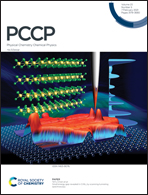Interface coupling and charge doping in graphene on ferroelectric BiAlO3(0001) polar surfaces†
Abstract
The ferroelectric field-effect transistors (FeFETs) based on graphene/ferroelectric (Gr/FE) hybrid systems have been attracting a lot of attention in recent years. The interface interaction and charge transfer between graphene and the ferroelectric substrates are important factors that determine the performance of graphene-based FeFETs. According to our intuitive sense, the electrostatically doped carriers in graphene on the ferroelectric positive and negative surfaces should be n-type and p-type, respectively. In the present work, however, by employing first-principles density functional theory (DFT) calculations, we reveal that an unusual charge doping effect occurs in graphene on the thermodynamically preferred ferroelectric BiAlO3(0001) polar surfaces. The graphene on the BiAlO3(0001) positive surface is electrostatically doped p-type, while the BiAlO3(0001) negative surface induces n-type carriers in the graphene overlayer. Further analysis demonstrates that, although the electrostatic doping effect in the Gr/FE system depends on the polarization direction of the ferroelectric substrate, the resultant carrier type and density in graphene are determined by the specific band arrangement between graphene and the ferroelectric polar surface. In addition to the graphene-based FeFETs, our results predict that the Gr/BiAlO3(0001) systems can be used to fabricate graphene p–n homojunctions by engineering the domain pattern in the ferroelectric substrate.



 Please wait while we load your content...
Please wait while we load your content...